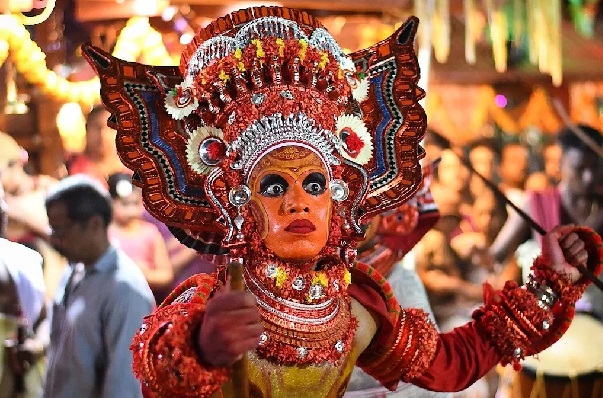RITUAL ARTS IN KERALA

Kerala, often referred to as “God’s Own Country,” is known for its rich cultural heritage, which includes a wide variety of ritual arts that have been preserved and practiced for centuries. These ritual arts are an integral part of Kerala’s traditional performing arts and reflect the state’s vibrant cultural diversity. Some of the prominent ritual arts in Kerala are:
THEYYAM
It is a dance form always performed by men glorifying the goddess kali who takes revenge over the monster Daruka and other vice characters. These are performed annually from December to April in the north Malabar areas. Theyyam is a popular ritualistic dance form performed in the northern parts of Kerala, particularly in the Malabar region. It is a unique blend of dance, music, and worship, where performers, known as “Theyyam artists,” embody various deities and mythological characters. Theyyam is often performed in temples and is believed to bring blessings and protection to the communities.
MUDIYETTU
It also enacts the rivalry between the goddess Kali and the Demon Daruka. This dance is performed by a particular caste called Kurup- panmar. This has also got special mention in UNESCO’S Representative list of the Intangible Cultural Heritage of Humanity. This art form is seen in the areas of Thrissur, Ernakulum, Kottayam and Idukki districts of Kerala between February and may after the harvesting season.
PADAYANI
This is a ritual that lasts a week. It is performed in the kali temples on the banks of the Pamba River during the months of March/April. The theme is same as that of Theyyam. It is also performed for the healing of some illness which is not possible by medicine. There will be many performers in this.
MARGAM KALI
It is dance form performed by the Syrian Christians which narrates the arrival of St. Thomas, the apostle – the miracles he performed and the hostility of the people among whom he worked. It is performed around a lamp which represents Christ and the performers represent his disciples.
These ritual arts of Kerala are not only a form of entertainment but also hold deep religious and cultural significance. They have been passed down through generations and continue to be cherished and celebrated as an essential part of Kerala’s cultural identity.